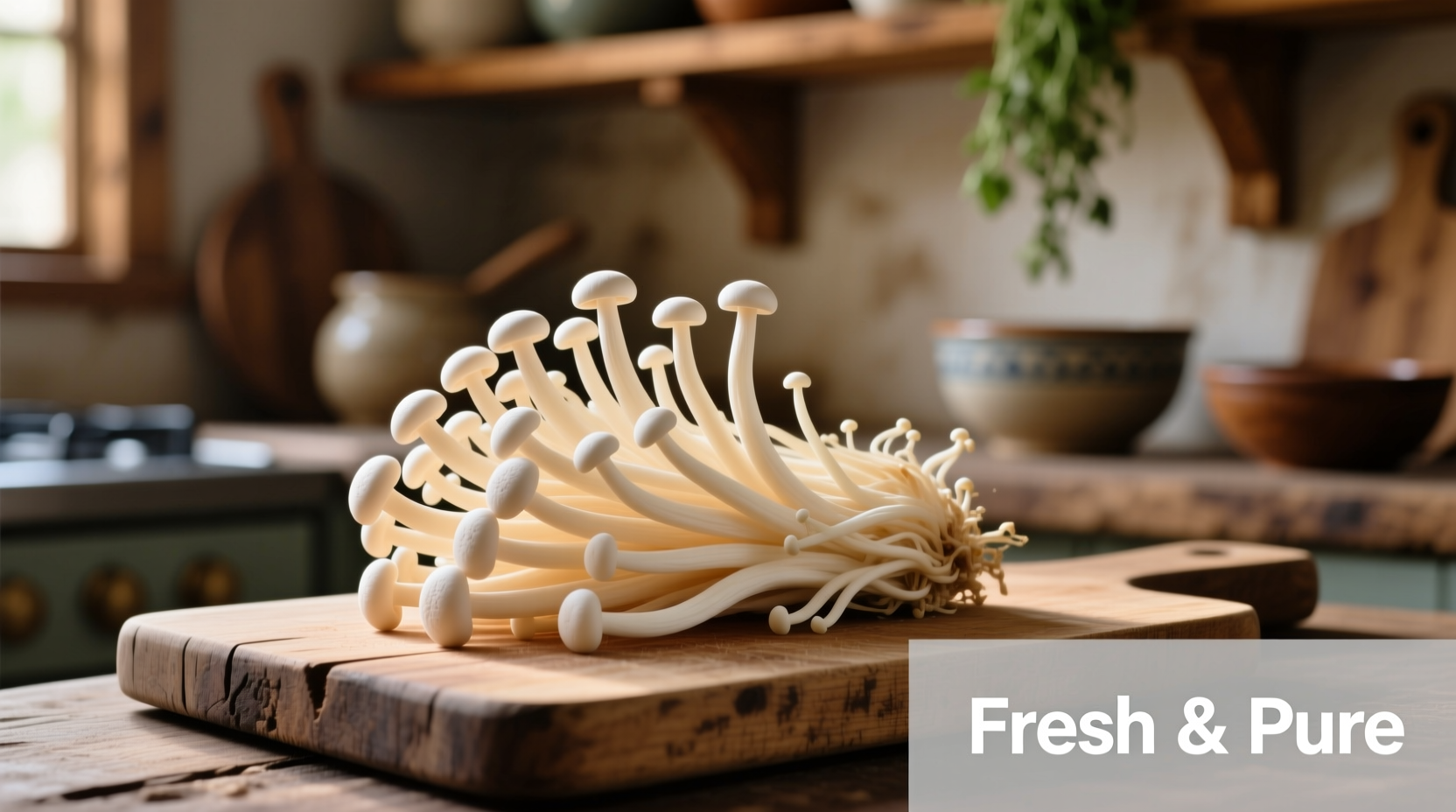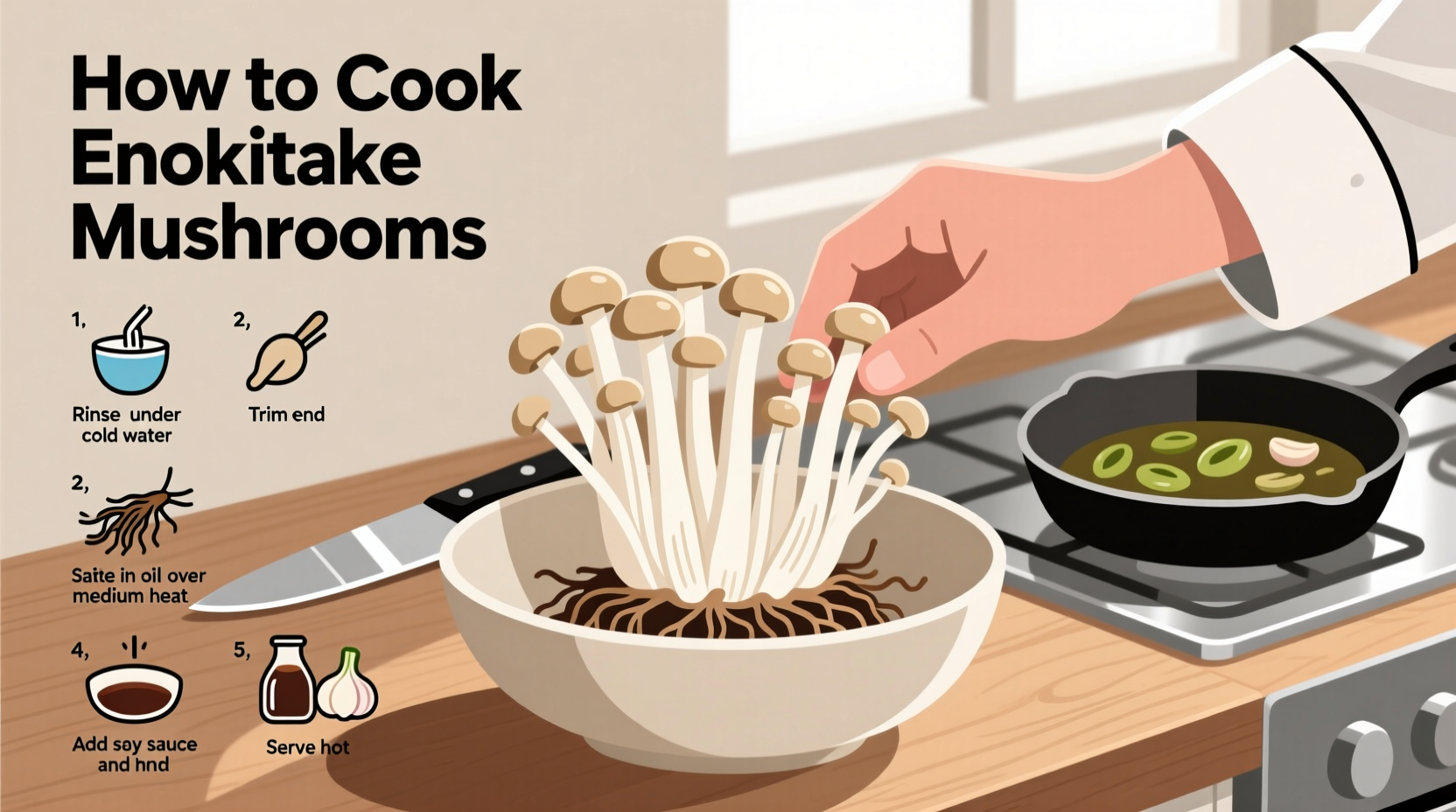Enokitake mushrooms should be trimmed at the base, gently separated into clusters, and cooked for 2-5 minutes depending on the method. Sautéing in butter or sesame oil brings out their delicate flavor while maintaining their signature crisp texture. Never overcook them, as they'll lose their unique crunch and become slimy.
Mastering Enokitake: Your Complete Cooking Guide
Discover exactly how to prepare and cook enokitake mushrooms to perfection. This guide reveals professional techniques that preserve their delicate flavor and signature crisp texture while avoiding common mistakes that ruin this specialty mushroom.
What Makes Enokitake Unique
Enokitake (Flammulina velutipes), also called golden needle mushrooms or winter mushrooms, feature long, slender stems with tiny caps. Unlike other mushrooms, they maintain a satisfying crunch even when cooked. Native to East Asia, these mushrooms grow in clusters with a mild, slightly fruity flavor that pairs beautifully with both Asian and Western dishes.
| Cooking Method | Time Required | Texture Result | Best For |
|---|---|---|---|
| Sautéing | 2-3 minutes | Crisp-tender with golden edges | Stir-fries, noodle dishes |
| Steaming | 3-4 minutes | Firm with slight softening | Soups, delicate presentations |
| Grilling | 4-5 minutes | Charred exterior, crisp interior | Appetizers, side dishes |
| Raw | None | Firm and crunchy | Salads, garnishes |
Step-by-Step Preparation Timeline
Follow this precise sequence for perfect enokitake every time:
- Selection (30 seconds): Choose firm, white clusters with tightly closed caps. Avoid slimy or discolored mushrooms.
- Trimming (45 seconds): Cut 1/2 inch from the base where stems are connected.
- Separating (1 minute): Gently pull clusters apart into manageable portions.
- Rinsing (20 seconds): Briefly rinse under cold water only if visibly dirty - avoid soaking.
- Drying (2 minutes): Pat dry with paper towels or use a salad spinner.
- Cooking (2-5 minutes): Apply your chosen cooking method with proper timing.
Professional Cooking Techniques
Each cooking method brings out different qualities in enokitake mushrooms. Understanding these differences helps you choose the right technique for your dish.
Sautéing for Maximum Flavor
Heat 1 tablespoon of neutral oil or butter in a skillet over medium-high heat. Add mushrooms in a single layer without overcrowding. Cook undisturbed for 1-2 minutes until golden, then toss for another minute. The USDA Food Safety and Inspection Service recommends cooking mushrooms to an internal temperature of 165°F (74°C) for food safety, which typically takes 2-3 minutes in a hot pan.
Steaming for Delicate Dishes
Place enokitake in a steamer basket over simmering water. Cover and steam for 3-4 minutes until slightly softened but still crisp. This method preserves their shape perfectly for soups and delicate presentations. According to the Academy of Nutrition and Dietetics, steaming helps retain more nutrients compared to boiling.
Grilling for Charred Complexity
Thread clusters onto skewers or use a grill basket. Brush with oil and grill over medium heat for 4-5 minutes, turning occasionally. The high heat creates beautiful char marks while maintaining their signature crunch.

Flavor Pairings That Shine
Enokitake's mild flavor works with numerous ingredients, but these combinations create exceptional results:
- Asian-inspired: Soy sauce, sesame oil, ginger, garlic, and scallions
- Creamy preparations: Butter, cream, Parmesan, and herbs
- Light broths: Dashi, miso, or clear chicken broth
- Acidic complements: Rice vinegar, citrus zest, or yuzu
Avoid These Common Mistakes
Many home cooks make these errors that compromise enokitake's quality:
- Overcooking: Results in slimy texture instead of crisp crunch
- Washing thoroughly: Mushrooms absorb water like sponges, making them difficult to brown
- Cooking from cold: Bring mushrooms to room temperature before cooking for even results
- Using low heat: Prevents proper browning and develops off-flavors
Storage Guidelines for Maximum Freshness
Store enokitake in their original packaging or in a paper bag in the refrigerator. They'll stay fresh for 5-7 days. Avoid plastic containers that trap moisture. The FDA recommends storing mushrooms separately from strong-smelling foods as they readily absorb odors.
When to Use Different Cooking Methods
The right cooking technique depends on your final dish:
- Stir-fries and quick dishes: Sauté briefly at high heat
- Miso soup and delicate broths: Add in the last 2 minutes of cooking
- Noodle dishes: Toss in during final minute of cooking
- Appetizers and presentations: Grill or pan-sear for visual appeal
- Salads and cold dishes: Use raw after a quick rinse
Safety First: Handling Mushrooms Properly
While enokitake are safe to eat when properly handled, follow these food safety guidelines from the FDA:
- Always wash hands before handling mushrooms
- Use separate cutting boards for mushrooms and raw meats
- Cook to an internal temperature of 165°F (74°C)
- Consume within 2 hours of cooking or refrigerate promptly
- Discard mushrooms with unusual odors or slimy texture
Simple Recipe Ideas to Try Tonight
Put your new skills to work with these straightforward preparations:
- Garlic Butter Enokitake: Sauté with butter, minced garlic, and parsley for 3 minutes
- Miso Soup Upgrade: Add to miso soup during the last 2 minutes of cooking
- Enokitake Stir-fry: Toss with soy sauce, sesame oil, and scallions in a hot wok
- Grilled Enokitake Skewers: Thread onto skewers, brush with teriyaki glaze, and grill











 浙公网安备
33010002000092号
浙公网安备
33010002000092号 浙B2-20120091-4
浙B2-20120091-4